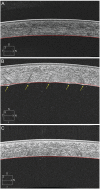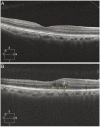Transient corneal edema is a predictive factor for pseudophakic cystoid macular edema after uncomplicated cataract surgery
- PMID: 25646056
- PMCID: PMC4309864
- DOI: 10.3341/kjo.2015.29.1.14
Transient corneal edema is a predictive factor for pseudophakic cystoid macular edema after uncomplicated cataract surgery
Abstract
Purpose: To report transient corneal edema after phacoemulsification as a predictive factor for the development of pseudophakic cystoid macular edema (PCME).
Methods: A total of 150 eyes from 150 patients (59 men and 91 women; mean age, 68.0 ± 10.15 years) were analyzed using spectral domain optical coherence tomography 1 week and 5 weeks after routine phacoemulsification cataract surgery. Transient corneal edema detected 1 week after surgery was analyzed to reveal any significant relationship with the development of PCME 5 weeks after surgery.
Results: Transient corneal edema developed in 17 (11.3%) of 150 eyes 1 week after surgery. A history of diabetes mellitus was significantly associated with development of transient corneal edema (odds ratio [OR], 4.04; 95% confidence interval [CI], 1.41 to 11.54; p = 0.011). Both diabetes mellitus and transient corneal edema were significantly associated with PCME development 5 weeks after surgery (OR, 4.58; 95% CI, 1.56 to 13.43; p = 0.007; and OR, 6.71; CI, 2.05 to 21.95; p = 0.003, respectively). In the 8 eyes with both diabetes mellitus and transient corneal edema, 4 (50%) developed PCME 5 weeks after surgery.
Conclusions: Transient corneal edema detected 1 week after routine cataract surgery is a predictive factor for development of PCME. Close postoperative observation and intervention is recommended in patients with transient corneal edema.
Keywords: Cataract; Corneal edema; Macular edema; Phacoemulsification; Risk factors.
Conflict of interest statement
No potential conflict of interest relevant to this article was reported.
Figures


Comment in
-
Pathophysiology of transient corneal edema and pseudophakic cystoid macular edema.Korean J Ophthalmol. 2015 Jun;29(3):203-4. doi: 10.3341/kjo.2015.29.3.203. Korean J Ophthalmol. 2015. PMID: 26028950 Free PMC article. No abstract available.
-
Author reply.Korean J Ophthalmol. 2015 Jun;29(3):204-5. Korean J Ophthalmol. 2015. PMID: 26219128 No abstract available.
Similar articles
-
Impact of allergy and atopy on the risk of pseudophakic cystoid macular edema.Graefes Arch Clin Exp Ophthalmol. 2016 Dec;254(12):2417-2423. doi: 10.1007/s00417-016-3474-z. Epub 2016 Aug 24. Graefes Arch Clin Exp Ophthalmol. 2016. PMID: 27553052
-
Preexisting epiretinal membrane is associated with pseudophakic cystoid macular edema.Graefes Arch Clin Exp Ophthalmol. 2018 May;256(5):909-917. doi: 10.1007/s00417-018-3954-4. Epub 2018 Mar 21. Graefes Arch Clin Exp Ophthalmol. 2018. PMID: 29564551
-
PREOPERATIVE VITREORETINAL INTERFACE ABNORMALITIES ON SPECTRAL DOMAIN OPTICAL COHERENCE TOMOGRAPHY AS RISK FACTOR FOR PSEUDOPHAKIC CYSTOID MACULAR EDEMA AFTER PHACOEMULSIFICATION.Retina. 2019 Nov;39(11):2225-2232. doi: 10.1097/IAE.0000000000002298. Retina. 2019. PMID: 30157113
-
Pseudophakic cystoid macular edema.Curr Opin Ophthalmol. 2012 Jan;23(1):26-32. doi: 10.1097/ICU.0b013e32834cd5f8. Curr Opin Ophthalmol. 2012. PMID: 22134362 Review.
-
Cystoid macular edema associated with preservative-free latanoprost after uncomplicated cataract surgery: case report and review of the literature.BMC Res Notes. 2017 Mar 20;10(1):127. doi: 10.1186/s13104-017-2448-5. BMC Res Notes. 2017. PMID: 28320481 Free PMC article. Review.
Cited by
-
Central corneal thickness determination in corneal edema using ultrasound pachymetry, a Scheimpflug camera, and anterior segment OCT.Graefes Arch Clin Exp Ophthalmol. 2015 Jul;253(7):1105-9. doi: 10.1007/s00417-015-2998-y. Epub 2015 Apr 21. Graefes Arch Clin Exp Ophthalmol. 2015. PMID: 25896108
-
Incidence of Pseudophakic Cystoid Macular Oedema Post-Cataract Surgery in Illawarra Shoalhaven Local Health District, Australia.Biomed Hub. 2022 Jan 18;7(1):1-10. doi: 10.1159/000521053. eCollection 2022. Biomed Hub. 2022. PMID: 35223872 Free PMC article.
-
Topical nepafenac for prevention of post-cataract surgery macular edema in diabetic patients: patient selection and perspectives.Clin Ophthalmol. 2017 Dec 11;11:2183-2190. doi: 10.2147/OPTH.S132810. eCollection 2017. Clin Ophthalmol. 2017. PMID: 29269999 Free PMC article. Review.
-
Clinical evaluation of corneal changes after phacoemulsification in diabetic and non-diabetic cataract patients, a systematic review and meta-analysis.Sci Rep. 2017 Oct 26;7(1):14128. doi: 10.1038/s41598-017-14656-7. Sci Rep. 2017. PMID: 29074989 Free PMC article.
-
Risk Factors and Cumulative Incidence of Cystoid Macular Edema After Simple Cataract Surgery: A Systematic Review and Meta-Analysis.Cureus. 2025 May 16;17(5):e84212. doi: 10.7759/cureus.84212. eCollection 2025 May. Cureus. 2025. PMID: 40525008 Free PMC article. Review.
References
-
- Halpern DL, Pasquale LR. Cystoid macular edema in aphakia and pseudophakia after use of prostaglandin analogs. Semin Ophthalmol. 2002;17:181–186. - PubMed
-
- Henderson BA, Kim JY, Ament CS, et al. Clinical pseudophakic cystoid macular edema: risk factors for development and duration after treatment. J Cataract Refract Surg. 2007;33:1550–1558. - PubMed
-
- Loewenstein A, Zur D. Postsurgical cystoid macular edema. Dev Ophthalmol. 2010;47:148–159. - PubMed
MeSH terms
Substances
LinkOut - more resources
Full Text Sources
Other Literature Sources

